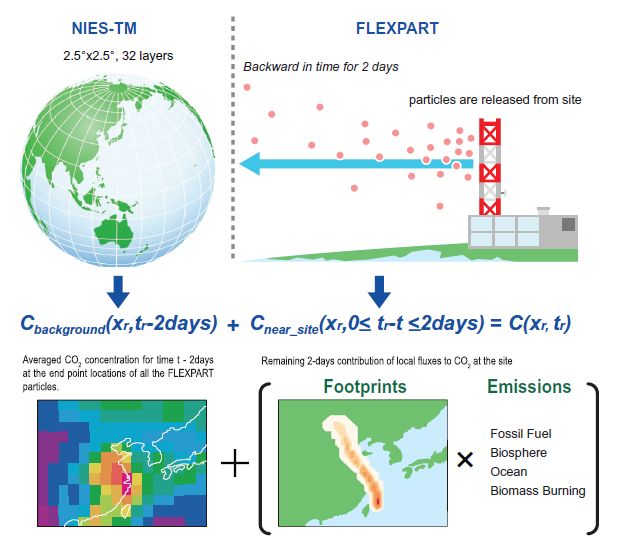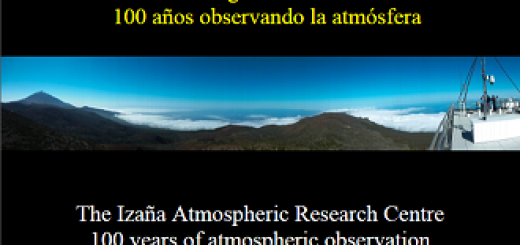New study published in Tellus B. A decadal inversion of CO2 using the Global Eulerian–Lagrangian Coupled Atmospheric model (GELCA): sensitivity to the ground-based observation network
![]()

A group of scientists working mainly in Japanese and Russian institutions has published a study in the scientific review Tellus B. This scientific paper presents the atmospheric-carbon-dioxide assimilation system of the Global Eulerian-Lagrangian Coupled Atmospheric (GELCA) transport model of the National Institute for Environmental Studies (NIES) of Japan. A researcher from Izaña Atmospheric Research Center has participated in this study contributing to the evaluation, flux inversion, interpretation of the results, and writing of the article (not in the development of the model nor the assimilation system).
Because this scientific paper is very technical, we only present here some simple explanations that try to provide the reader some superficial understanding about this topic. An atmospheric transport model consists in a numerical (mathematical) model that given an initial spatial distribution of concentration of a given trace gas (e.g., carbon dioxide) in the atmosphere, computes the time evolution of the concentration of this trace gas in the atmosphere solving a set partial differential equations. These equations take into account that the trace gas is transported by the wind field, but also dispersed due to turbulence and convection. There are also surface (oceanic and land) sources and sinks of the trace gas to be taken into account by the model (there might be also volumetric sinks within the atmosphere in case of trace gases that react chemically in the atmosphere, but this is not the case for carbon dioxide).
The surface sources and sinks are known with high uncertainty (emission inventories, vegetation models, ecosystem trace gas flux measurements…). Using a transport model and atmospheric measurements of trace gas concentration in many stations, the surface sources and sinks can be known better performing an “Inversion”. The procedure is as follows: 1) the a priori surface fluxes are used in a forward run of the transport model; 2) the simulated trace gas concentrations simulated for each time step are compared with the concentrations really measured; 3) from these differences in concentration, the improvements that need to be applied to the surface fluxes to minimize those differences can be deduced; and therefore, a more accurate a posteriori value for the surface fluxes can be obtained.
The transport model used in this study is particularly complex and efficient due to the fact that it consists in the coupling of an Eulerian and a Lagrangian model, continuously in time. Eulerian models are better for the global scale and long times of simulation, whereas Lagrangian models are better for small scales and short times. The GELCA model combines both types of model to obtain simultaneously the advantages of both of them: global coverage and high spatial resolution near the observation stations.
After presenting the assimilation system, this study conducted sensitivity tests to examine the impact of the site selections and the prior uncertainty settings of observation on the inversion results. For these sensitivity tests, five different site/data selections from the ObsPack product were used. In all cases, the time series of the global net CO2 flux to the atmosphere stayed close to values calculated from the growth rate of the observed global mean atmospheric CO2 mixing ratio. At regional scales, estimated seasonal CO2 fluxes were altered, depending on the CO2 data selected for assimilation. For most observation sites, the model–data mismatch was reasonably small. Regarding regional flux estimates, tropical Asia was one of the regions that showed a significant impact from the observation network settings. We found that the surface fluxes in tropical Asia were the most sensitive to the use of aircraft measurements over the Pacific due to the very sparse available surface observations in tropical Asia and the deep convection presents very frequently in this region. The seasonal cycle agreed better with the results of bottom-up studies when the aircraft measurements were assimilated. These results confirm the importance of these aircraft observations, especially for constraining surface fluxes in the tropics.

Figure 1. Schematic diagram of GELCA inverse modelling framework.
More information about this study is available in the published scientific article:
Shirai, T., M. Ishizawa, R. Zhuravlev, A. Ganshin, D. Belikov, M. Saito, T. Oda, V. Valsala, A.J. Gomez-Pelaez, R. Langenfelds, and S. Maksyutov; A decadal inversion of CO2 using the Global Eulerian–Lagrangian Coupled Atmospheric model (GELCA): sensitivity to the ground-based observation network, Tellus B: Chemical and Physical Meteorology, Vol. 69 , Iss. 1, 2017







